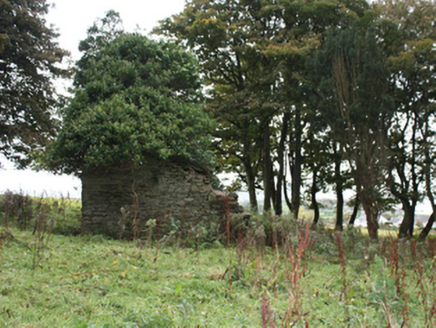Survey Data
Reg No
40820020
Rating
Regional
Categories of Special Interest
Architectural, Artistic, Social
Previous Name
Glen gollen
Original Use
Mausoleum
Date
1830 - 1870
Coordinates
235000, 426562
Date Recorded
17/10/2008
Date Updated
--/--/--
Description
Remains of freestanding burial vault or chapel, built c. 1850, originally associated with the Norman family of Glengollan (house now demolished). Now ruinous and partially collapsed. Rubble stone walls remaining to the north, south and mainly to the east sides, east wall now largely observed with vegetation. Shallow segmental headed window opening to the surviving east gable end having cut stone intersecting\double Y-tracery. Located in the centre of field adjacent to the east of former walled garden complex (see 40820019) associated with Glengollan, to the east of the site of Glengollan, and to the north-east of Fahan.
Appraisal
This curious feature was probably originally built as a family vault associated with the Norman family of Glengollan, now demolished. It may possibly have been built as a folly or ‘eye-catcher’ in the estate. It survives in a dilapidated condition but is a feature of some historic interest in the rural landscape to the north-east of Fahan, and to the east of the site of the main house. It dates to around 1850 (not on Ordnance Survey first edition six-inch map of c. 1837, depicted on Valuation map of c. 1860). Of particular note is the fine window with well-crafted cut stone intersecting tracery to the surviving east gable, which is of artistic merit and is clearly the work of skilled masons. Interestingly, this tracery appears to have been based that to the east window found at the now ruinous seventeenth century parish church (see 40820016) in Fahan, which is sites to the south-west. Glengollan was one of the major estates in the area. In 1876 the then owner, Thomas Norman, owned an estate totally some 5,411 acres. Glengollan was the home of Thomas Norman who died in 1833, and Lewis (1837) records that this house was the residence of Charles Norman, Esq. at this time. It was later the residence of a Capt. Thomas Norman in 1894 (Slater’s Directory), High Sherriff of Donegal in 1864. His son Capt. Charles Norman, served as High Sherriff of Donegal but was killed in action at the Somme in 1917. One of the Norman family of Fahan, a Conolly Norman (1853-1908) was a noted surgeon who was superintendent of the Richmond Asylum in Dublin, where he instigated improved methods of treatment. He is mentioned in the first chapter of James Joyce’s Ulysses. This curious feature, despite its condition, is an integral element of the built heritage of the local area, and acts as an historic reminder of Glengollan and the Norman family who resided there. It forms part of a group of related structures along with the fragmentary remains of the former walled garden (see 40820019) to the west, and the former gateway (see 40820015) to the south-west.





